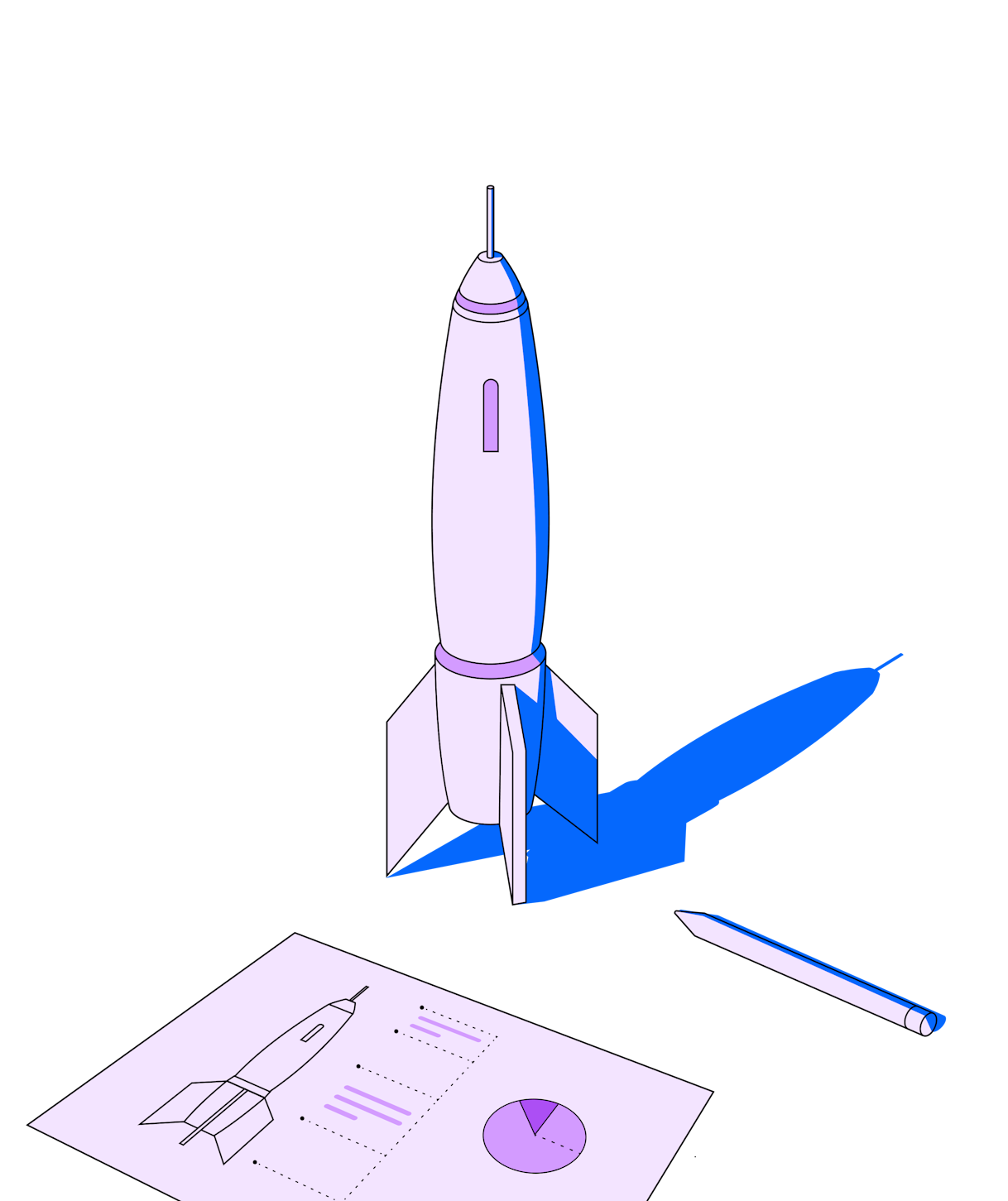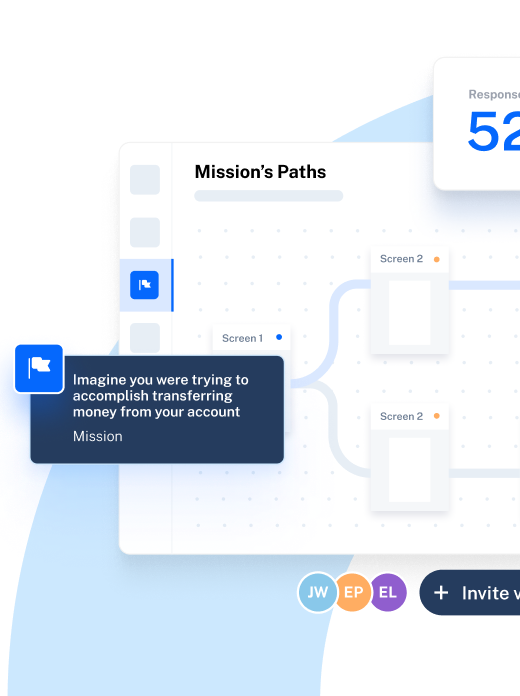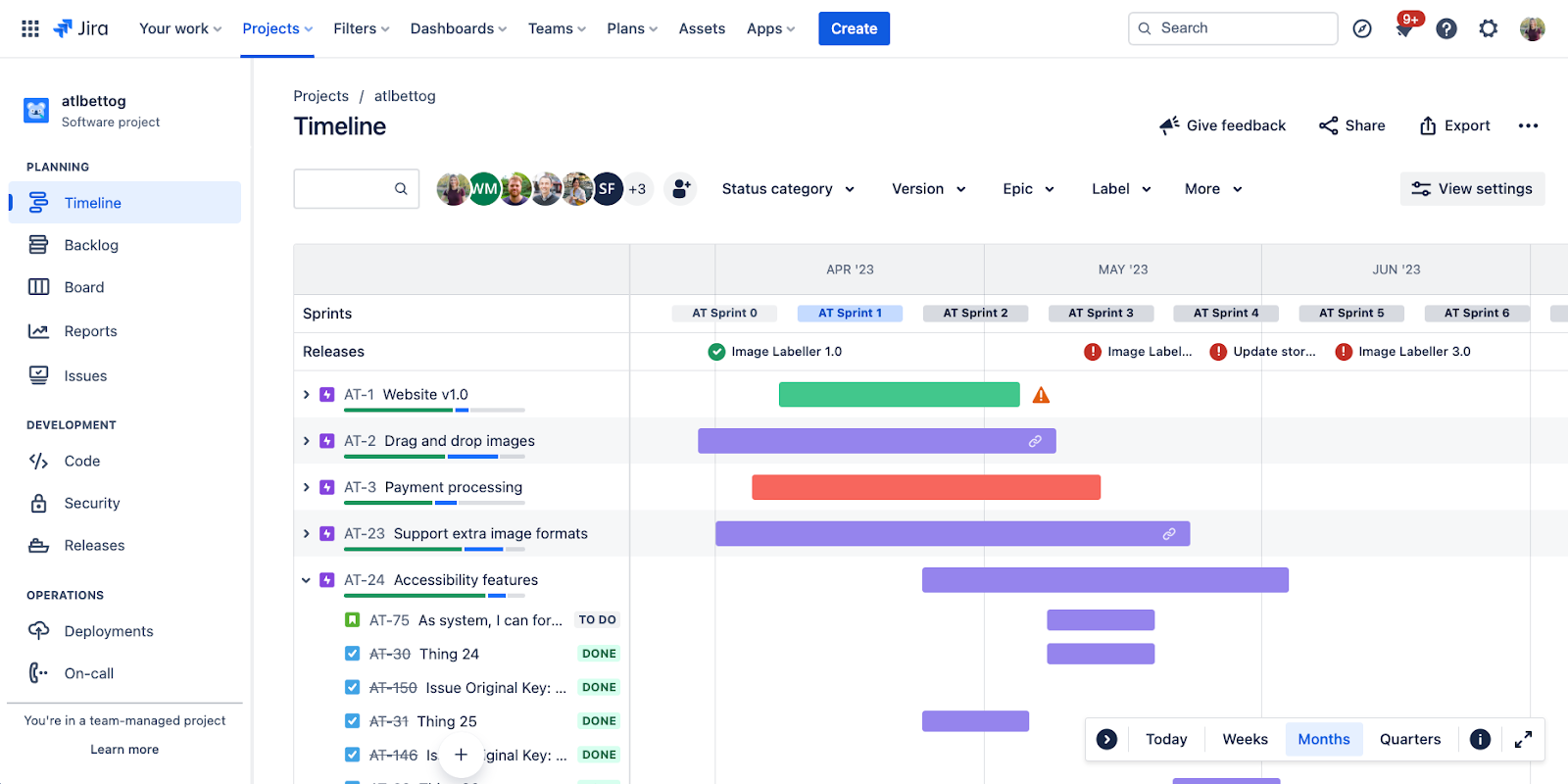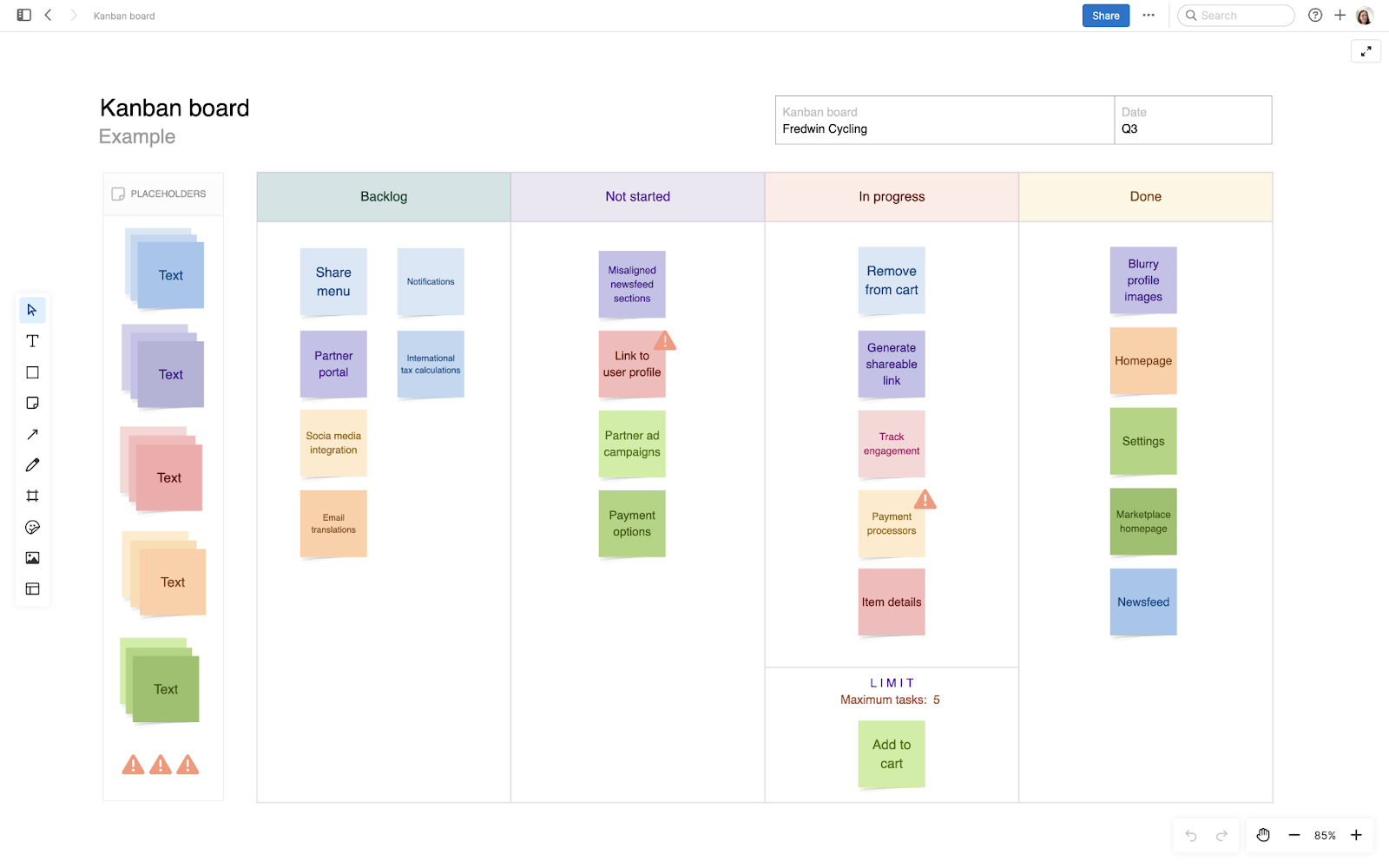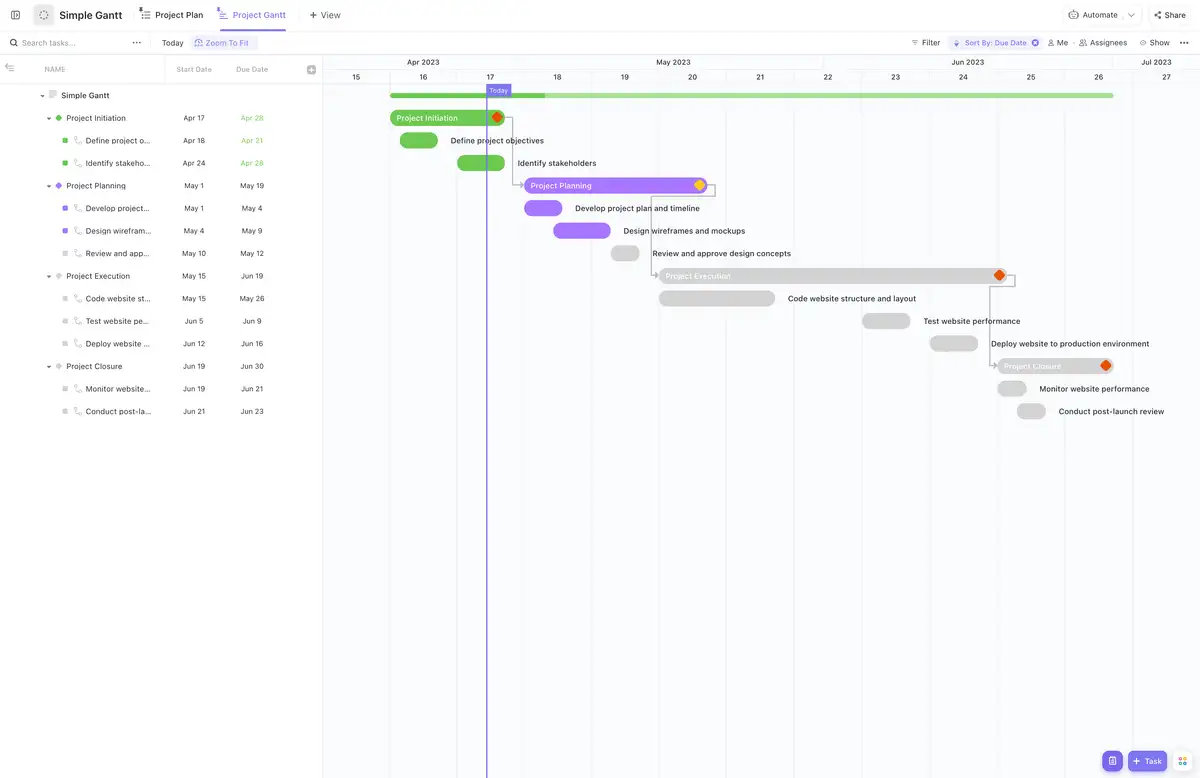Without a product development roadmap to take you from concept to launch, it’s all too easy to get stuck in a never-ending loop of ‘coming soon’. Features get missed in the development shuffle, deadlines become distant, and frustration fractures the team.
With a product development roadmap, on the other hand, you hit each milestone en route to launch, delivering a product your team is proud of and your users love. A clear roadmap transforms your brilliant idea from a jumbled concept to a market-ready success story.
This guide shows you how to build a roadmap that keeps your team focused, your stakeholders happy, and your launch on-track for success. We’ll also share three example product development roadmaps to get you started straight away.
What is a product development roadmap and why do you need one?
A product development roadmap outlines the ‘why’ and details the ‘how’—transforming ideas into well-defined, actionable steps.
It’s the blueprint for your SaaS product’s development. A visual, prioritized plan that outlines the features, updates, and overall direction of your product development projects.
Let's say you're building a project management SaaS tool. Your initial roadmap might focus on core functionalities like task creation, assignment, and tracking. Later phases could introduce features like team collaboration tools, advanced reporting, and integrations with other popular apps. The roadmap ensures a logical flow of development, prioritizing features that deliver the most value to users at each stage.
A product development roadmap helps you:
- Guide strategic vision: Think of it as the GPS for your product's journey—it shows the destination and the path, synchronizing everyone’s efforts from the get-go.
- Break down silos: A roadmap aligns cross-functional teams, from design to development. It’s a source of truth for project management roles and responsibilities, and prevents overlaps and gaps in the product development process.
- Secure market and competitive advantage: Stay sharp and agile: the roadmap is a living document, not set in stone. As you gather customer needs and market data, priorities can shift. A roadmap allows you to adapt and course-correct when necessary, without starting from scratch.
- Boost customer feedback and satisfaction: It keeps your product oriented with what users want and need, ensuring product success and turning happy users into loyal customers.
- Optimize resource management: A roadmap helps you manage and channel your resources to high-impact features and tasks, maximizing returns on every dollar spent.
Product development roadmap vs. product roadmap: What’s the difference?
While the terms sound similar, there's a key difference:
A product development roadmap focuses on the creation and evolution of a specific product, detailing the phases of its development from concept to launch and updates. The time frame is short-term (quarters) with iterative cycles (sprints).
A product roadmap is broader. It outlines the product strategy and timelines of multiple releases (new product or features) under a company’s portfolio, including their development and market introduction. The time frame includes long-term goals (12+ months).
Here’s a quick overview:
Product development roadmap | Product roadmap | |
|---|---|---|
Scope | Focuses on a single product’s development | Covers product strategy and overall goals |
Detail level | Highly detailed, with phases and milestones for development—initial design to testing and final deployment | More strategic, less granular—highlights major milestones and strategic goals |
Audience | Primarily for internal teams like development and design | Broader audience, including executives, stakeholders, and sometimes customers |
Purpose | To guide the product development process of a product | To align product strategy with business objectives, often influencing investment and market positioning decisions |
Content | Specific features, technical specifications, detailed timelines, and resource allocation | General release goals, strategic initiatives, and high-level product features across multiple products E.g., rollout of a new line of smart home devices |
What’s included in a product development roadmap?
A product development roadmap typically includes several key components that guide the development process from conception to launch and help with stakeholder buy-in.
Here's what it should include:
- Product development vision and business goals—the big ‘why’: This section outlines the purpose of your product and its expected impact. You need to answer questions like “Where is our product headed?” and “What problems are we solving?” (E.g., Our goal is to become the go-to design collaboration platform).
- Initiatives and epics: Outline the major product development themes or projects that contribute to achieving your product goals. One epic might be ‘To improve team collaboration features’. This could include sub-initiatives like ‘Integrate real-time chat’ and ‘develop in-app annotation tools’.
- Features and user stories: Break down initiatives into specific features that deliver value to users. User stories or customer research help capture the who, what, and why of each feature. (E.g., As a designer, I want real-time chat to discuss designs faster.)
- Timelines, release dates, and milestones: These are high-level timeframes for initiatives, with checkpoints to track progress. Be flexible—you might need to adapt timelines. (E.g., Target launching real-time chat by Q3 2024, with a beta test milestone set for July.)
- Resources: List the budget, team members, tools, or technology allocated to different project segments. (E.g., Allocate $50,000 and three full-time developers for the initial mobile app development phase.)
- Dependencies: Identify any roadblocks between features or initiatives. (E.g., In-app chat depends on the core API update.)
- Success metrics: Define how you'll measure the impact of each initiative. (E.g., Decrease bug frequency; increase the number of active users or customer satisfaction rates after launching a product feature.)
3 Types of product development roadmaps
Your product development roadmap is a powerful tool, but there's no one-size-fits-all approach. The best format depends on your development style and goals.
Here are three types of roadmaps you can use for your product development project to help keep everything on track.
Agile roadmap
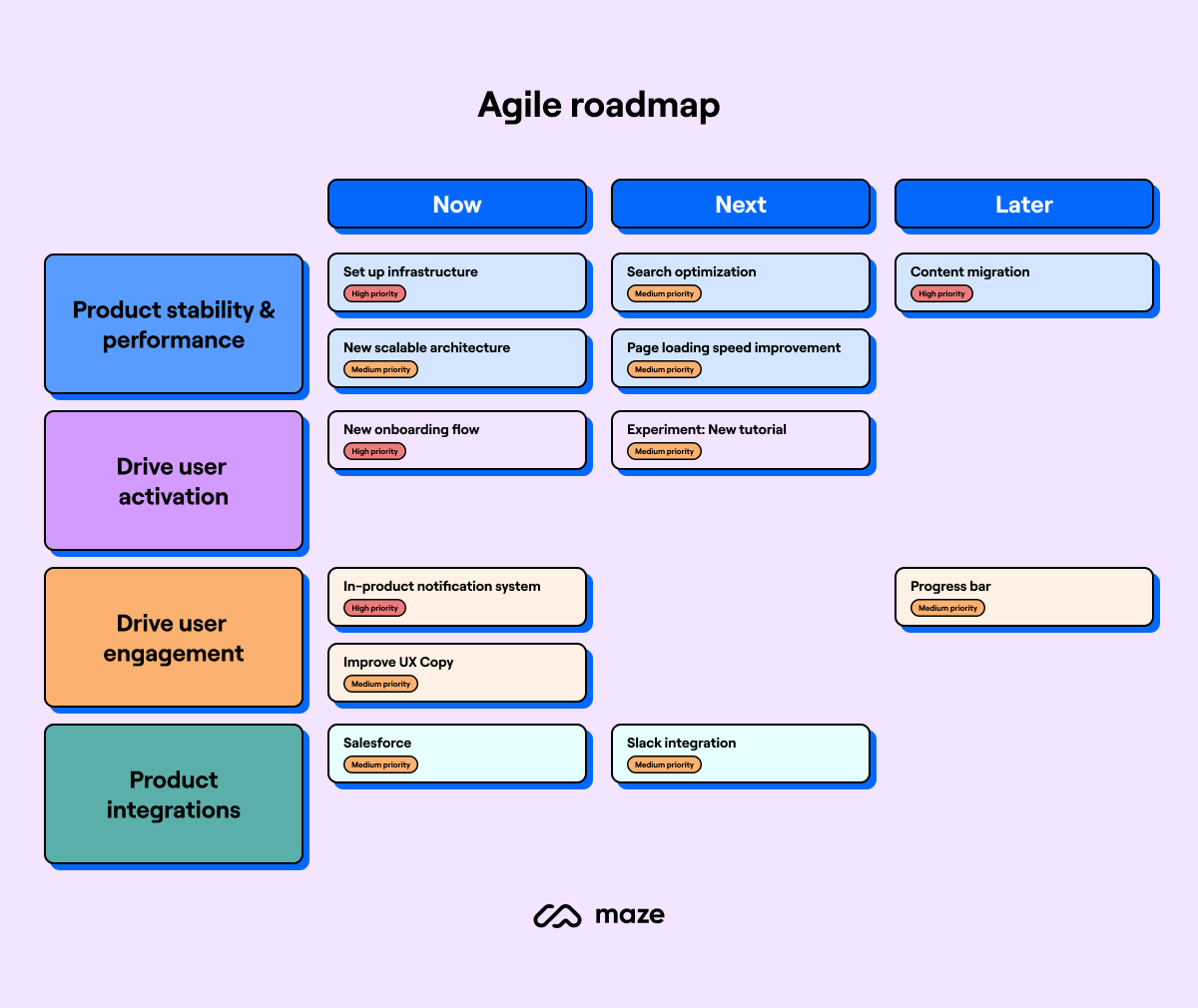
An agile product development roadmap prioritizes themes (big-picture goals) and initiatives (projects within themes) that align with your product vision. It focuses on flexibility, incremental progress, and continuous feedback.
For example, if you’re developing a new customer relationship management (CRM) feature, an agile roadmap for this product would list phases like:
Upcoming features, like product analytics or integration capabilities
Allocating time for revising these features based on user feedback
Iterative testing
Each roadmap phase would be broken down into sprints—short, manageable periods during which specific tasks are completed and reviewed.
Waterfall roadmap
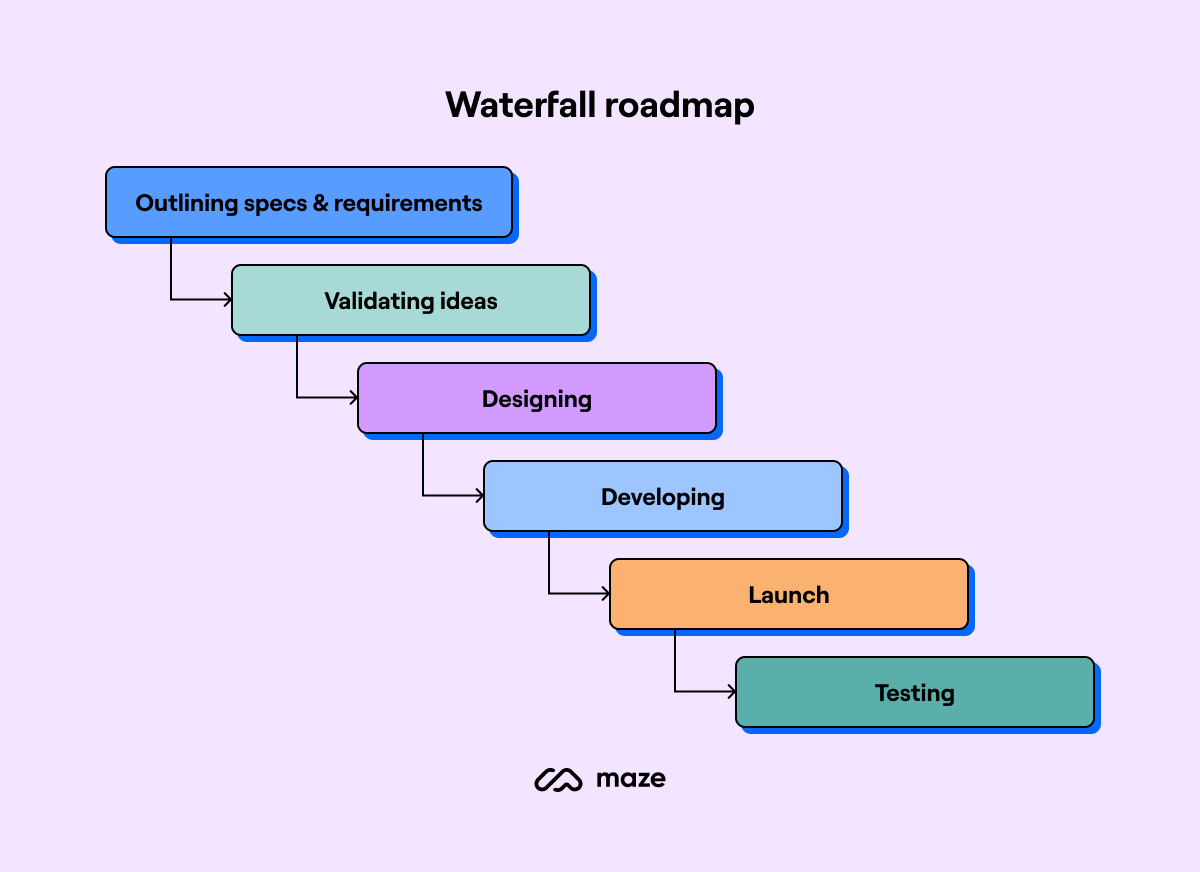
The waterfall product development roadmap is linear. The project progresses through well-defined, orderly stages. It starts with requirement analysis, followed by design, implementation, testing, and maintenance. Each phase must be completed before the next begins, and there's no overlap.
The waterfall model's structured nature suits projects where changes are costly or where regulatory and compliance requirements demand strict adherence to the process.
Hybrid roadmap
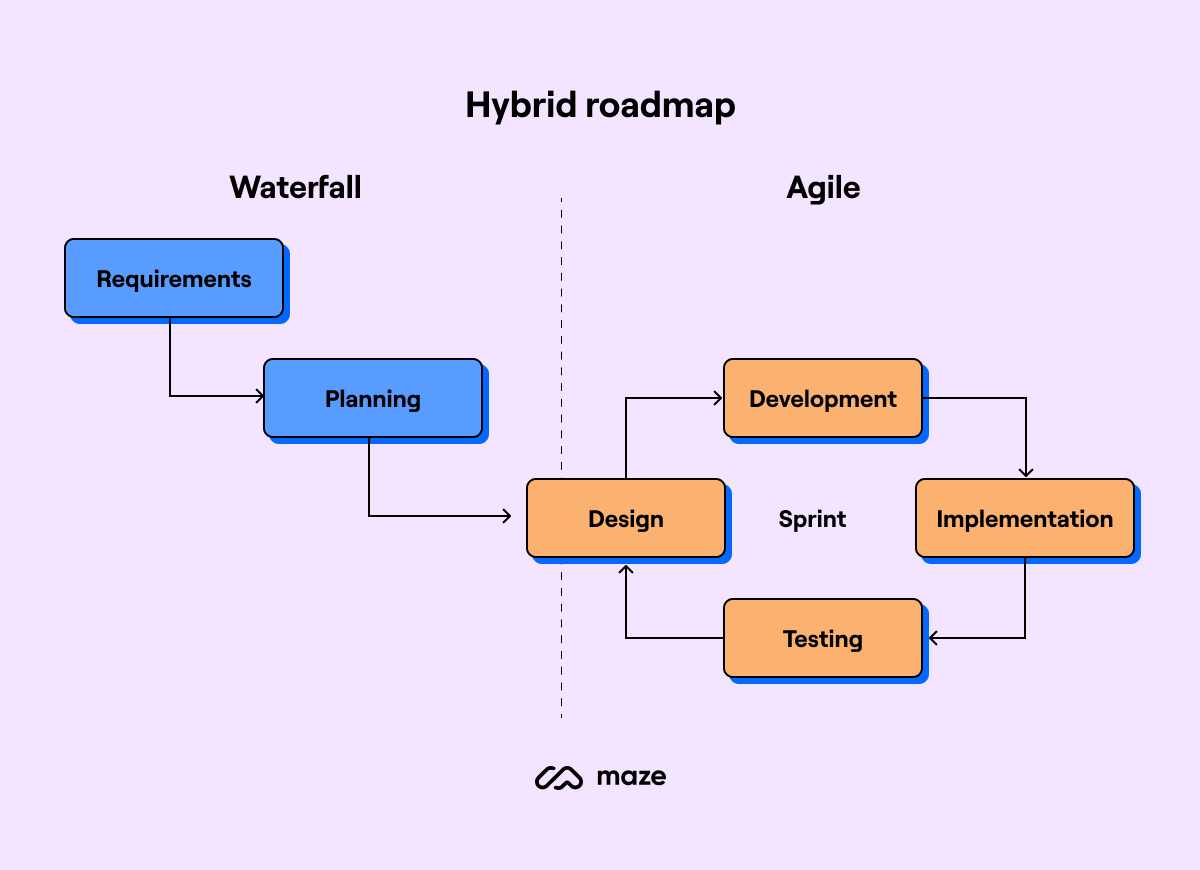
A hybrid product development roadmap blends the structured planning of the waterfall methodology with the flexibility and iterative approach of agile.
In a hybrid approach, you might use waterfall for defining the product development project’s broad scope and major milestones, which are less likely to change. This helps in setting clear deadlines and resource allocation.
Agile practices can then be employed to handle more dynamic aspects of the project, like updates and refinements based on user testing and feedback.
The hybrid method boosts collaboration across different teams, accommodates various workflow preferences, and maintains overall project alignment with strategic goals.
6 Steps to create a product development roadmap
Having a clear vision for your product's immediate future is essential—and translating that vision into actionable steps requires a product development roadmap.
Here are six steps to create a roadmap that guides your development team toward success.
1. Define your product development strategy and goals
By the time you get to creating a product development roadmap, you’ll likely have an idea of the project you’ll be working on. You may not have the specific initiatives (they’ll come with your product discovery, but you’ve got your overarching product development focus.
For example, you could be creating a product development roadmap following some less-than-satisfactory product experience survey results. Defining your product development strategy involves outlining the phases of your project and the research methodologies you’ll use to hit your goal—in this case, improving your product’s usability.
2. Agree on which teams and individuals own each task
Second, you need to define the roles and responsibilities for all team members involved in the project. Consider setting swimlanes—a horizontal band that visually represents a specific team, department, or even a stage in the development process.
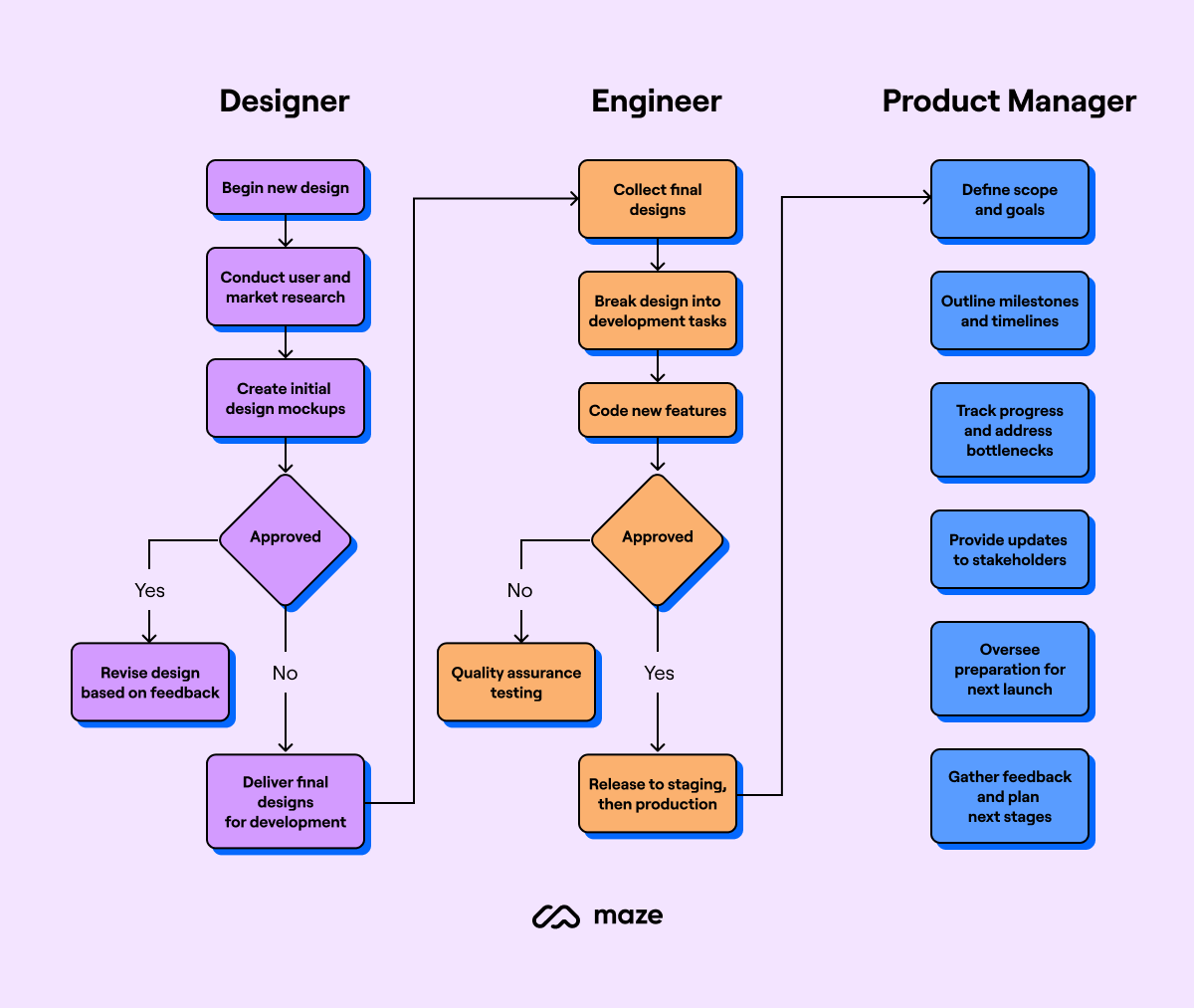
Some common use cases for swimlanes in product roadmaps include:
- Team-based swimlanes: Dedicate a lane to each development team (engineering, design, marketing) to see their assigned features and timelines
- Stage-based swimlanes: Create swimlanes for different stages in the development process (ideation, development, testing, launch). This allows you to see which features are in what stage of development and easily identify any bottlenecks.
- Product-based swimlanes: If managing multiple products (e.g., mobile app, web app), dedicate a swimlane to each product. This visualizes each product's roadmap independently, keeping things organized and focused.
3. Conduct user research to prioritize initiatives
User research is a crucial part of product development. Without UX research, you’re basing big decisions on assumptions—when you could be basing them on data.
You’ll turn to users for their product feedback throughout the product development process, but this first research study is to help identify the most pressing issues among your users. It’s exploratory research to dig deeper into user issues to identify and prioritize specific product development initiatives.
For example, let’s go back to our example of poor product experience survey results. You know there’s an issue, but you’re not certain exactly what with. Some qualitative research data from the survey points towards some issues, but you really need to find out more.
To help identify and prioritize issues, you conduct user interviews. These interviews uncover specific problems that users face within your product. One user complains about the native automations, others complain about the font size, and one complaint pops up again and again: the product’s navigation doesn’t make sense to users.
With this information, you’re ready to move on to the next step.
Need a tool to help conduct decision-driving user research? Maze’s comprehensive suite of research methods provides teams with the tools they need to get game-changing insights. From Interview Studies to Feedback Surveys, Prototype Testing to Card Sorting—Maze has you covered.
4. Map out development phases and release dates
Now that you know what issues are affecting users, you can start populating your roadmap with initiatives. You want to prioritize these initiatives based on:
- Impact: how important is this to users? How much would solving this problem improve their experience?
- Effort/feasibility: can we actually do this with the resources we have? How much effort would this take us to action?
- Business value: does working on this development support our wider business goals?
You then want to consider these three aspects to prioritize projects. High impact and low effort? Sounds like a winner. Low impact but high effort? Steer clear. Low impact but low effort? It can wait until you’ve addressed critical issues.
Once you’ve prioritized initiatives, you can get even more granular and start setting milestones and timeframes. Each initiative is its own mini-project—complete with UX research objectives, methodologies, and success criteria.
You want your product development roadmap to clearly map out your goals and how you’ll get there—completing this step puts a check in both of those boxes.
5. Establish automations and repeatable process
Now you’ve filled out your product development roadmap with project-specific information, you’re ready to consider the functionality of your roadmap.
This step helps simplify your product development workflow. It reduces manual effort and ensures consistency. Start by identifying repetitive and time-consuming tasks within your development cycle. This might include code deployments, testing, data entry, or report generation. For example, if your team frequently runs the same set of tests after each code change, this is a prime candidate for automation.
Next, select appropriate tools to automate these tasks. Continuous integration/continuous deployment (CI/CD) tools can automate the process of building, testing, and deploying code. For UX research reports, you can opt for a research platform that pulls results and key user insights together automatically, like Maze.
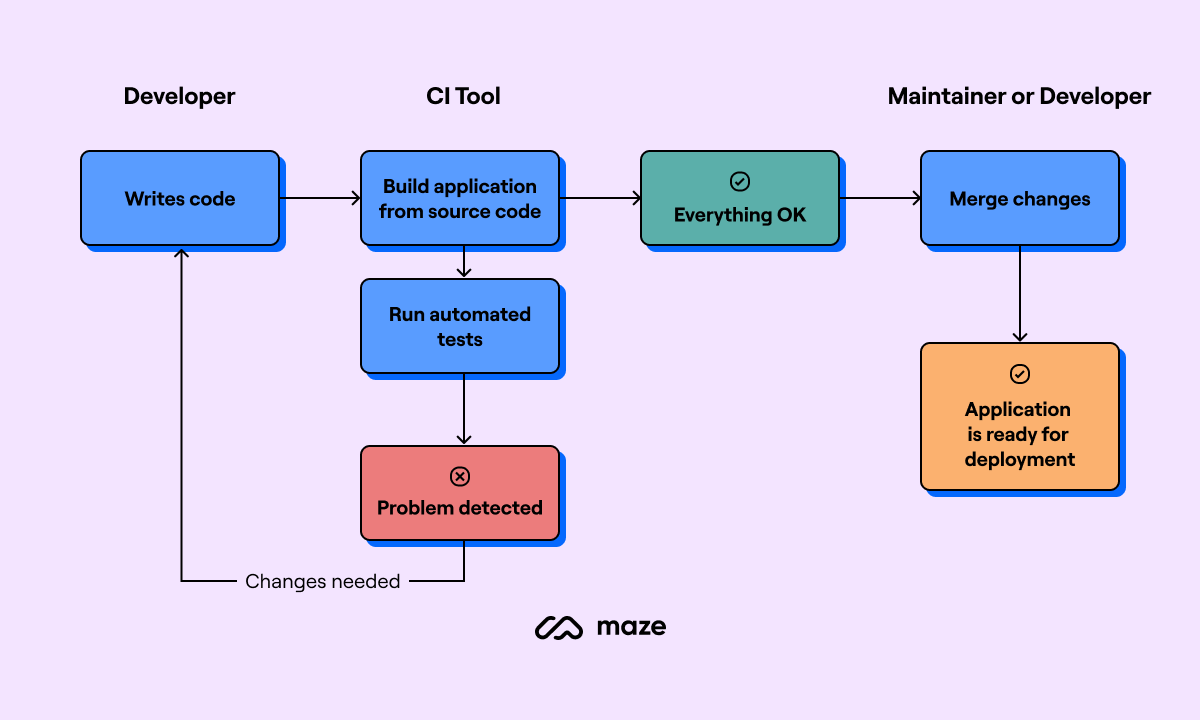
In addition to automation, you can create templates for repeatable processes. For example, develop standardized templates for project documentation, user stories, and test cases.
These templates reduce the time spent on creating these documents from scratch, and also ensures all team members follow the same format and include necessary information every time.
6. Start actioning the roadmap you’ve created
Congrats! You’ve now successfully created a product development roadmap. The final step in this project is to follow the process and timelines you’ve just laid out. This looks different for everyone involved, as different team members have different roles in the product development process.
Remember that your roadmap is a guide. It’s not set in stone—you can update it if necessary, and revisit it after projects to see what worked and what didn’t. It’s the source of truth for all teams involved in the product development process—so make sure it’s an accurate reflection of where each initiative is.
3 Product roadmap templates to inspire you
Many roadmapping tools offer pre-built templates to jumpstart your planning. Let’s look at some inspiring examples to help you visualize your product's journey:
1. Stay agile: Jira’s roadmap template
Jira's agile roadmap template prioritizes adaptability within the agile framework. You can visualize your product's strategic direction with clear timelines and sprints. Collaboratively prioritize features, manage tasks, and track progress. Your team can also adjust plans as needed, ensuring transparency and stakeholder alignment throughout the product development process.
2. See it, do it: The Aha! Kanban roadmap template
The Aha! Kanban board template lets you see your workflow in a flash. Just customize the columns for your process, then add cards for each task. Set limits to avoid overload and keep work moving. And if you’re stuck on something, the board highlights roadblocks for quick fixes. It's all about collaboration, so your team stays focused on delivering value, one task at a time.
3. Visualize with Gantt charts: ClickUp’s waterfall roadmap template
ClickUp's Simple Gantt Chart template makes project planning easy. Tasks from your ClickUp list automatically sync with the chart. You can see what's open, what's in progress, and what's done—all with a quick glance at the color-coded bars. This template works for all sorts of projects, no matter your style. ClickUp’s template is great for newbies and helps you spot roadblocks before they slow you down.
Power your product development with user research
A product development roadmap takes your product from a disorganized scribble on a whiteboard to a go-to-market-ready product.
Remember, a roadmap is all about:
- Focusing on features that bring the most value to users
- Embracing flexibility as you gather user feedback
- Keep your team and stakeholders on the same page with a clear and visually appealing roadmap
And if you’re feeling stuck on how to collect user feedback to inform your roadmap, Maze can help. With a user testing platform like Maze, you can upload prototypes, recruit testing participants, and download customizable actionable insights for stakeholder buy-in—all within a single platform.
Frequently asked questions about product development roadmaps
Why are product development roadmaps important?
Why are product development roadmaps important?
Product development roadmaps are important because they:
- Align internal and external stakeholders on strategic goals
- Provide a clear, structured plan for product development
- Boost communication and collaboration across teams
- Ensure efficient resource allocation and prioritization
- Improve decision-making and help teams avoid risks
- Keep the development process on track and adaptable to changes
What is agile product development?
What is agile product development?
Agile product development is a dynamic, iterative approach focused on creating products through short cycles called sprints. It focuses on continuous improvement, collaboration, and flexibility to adapt to changing requirements. Agile methodologies like scrum and kanban prioritize customer feedback and rapid delivery, and encourage collaboration between cross-functional teams.
